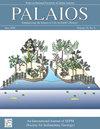砂岩层上的基尼亚型褶皱构造:非微生物诱导的同沉积地震变形特征
IF 1.5
4区 地球科学
Q2 GEOLOGY
引用次数: 4
摘要
摘要褶皱构造的一类,通常被称为Kinneyia构造或Runzel标志,包括典型的由吻合的、低起伏的、平顶隆起和中间凹陷组成的层理平面特征。地形起伏通常小于一毫米。它们局部常见于近海环境中与泥岩互层的细粒至中粒砂岩层的上表面,特别是在前寒武纪和下古生代地层中,但早在白垩纪就有。在过去的二十多年里,这些褶皱结构被广泛认为是微生物席造成的,并被认为是在微生物稳定沉积物的元古代占主导地位的证据,在显生宙,陆基海洋底栖生态逐渐让位给混合生态。然而,元古代、寒武纪和志留纪的一系列标本所显示的详细形态和交叉关系,使这种解释受到质疑。褶皱表面与生物碎屑(如贝壳)、先前和后来形成的冲刷面、水平和垂直的洞穴之间的关系表明,这些褶皱不是由于微生物垫层的表面地形或埋藏过程中微生物垫层的压实而形成的,而是在砂床顶部与上覆的泥浆层的界面处形成的。变形归因于低震级地震的振动。在一些硬化后形成的小型沉积片粒和裂缝阵列单元中的存在,以及当地相关的震积岩和附近断裂的其他证据,表明同沉积构造活动并非出乎意料,并支持这类褶皱构造是一种震积岩的解释。本文章由计算机程序翻译,如有差异,请以英文原文为准。
KINNEYIA-TYPE WRINKLE STRUCTURES ON SANDSTONE BEDS: NOT MICROBIALLY INDUCED BUT DEFORMATION FEATURES CAUSED BY SYNSEDIMENTARY EARTHQUAKES
Abstract: A category of wrinkle structures, often termed Kinneyia structure or Runzel marks, comprises bedding plane features consisting typically of anastomosing, low-relief, flat-topped ridges with intervening depressions. Topographic relief is usually less than a millimeter. They are locally common on the upper surfaces of fine- to medium-grained sandstone beds interbedded with mudstone deposited in offshore settings, especially in Precambrian and lower Paleozoic strata but as young as Cretaceous. For more than the last two decades these wrinkle structures have been widely regarded as due to microbial mats, and have been taken as evidence for dominance in the Proterozoic of microbially stabilized sediment and, in the Phanerozoic, a matground marine benthic ecology which gradually gave way to a mixground ecology. The detailed morphology and cross-cutting relationships demonstrated by a range of specimens of Proterozoic, Cambrian, and Silurian age, however, cast this interpretation into doubt. The relationship between the wrinkled surface and bioclasts such as shells and both prior- and later-formed scour surfaces, and horizontal and vertical burrows show that these wrinkles did not develop due to the surface topography of microbial mats or compaction of microbial mats during burial, but instead formed at the top of a sand bed at the interface with an overlying layer of mud. Deformation is ascribed to vibration from low-magnitude earthquakes. The presence in some units of small-scale sedimentary dikelets and crack arrays that formed later after some stiffening, along with locally associated seismites and other evidence for nearby faulting, show that syndepositional tectonic activity was not unexpected and support the interpretation that this category of wrinkle structures is a type of seismite.
求助全文
通过发布文献求助,成功后即可免费获取论文全文。
去求助
来源期刊

Palaios
地学-地质学
CiteScore
2.80
自引率
12.50%
发文量
40
审稿时长
6 months
期刊介绍:
PALAIOS is a monthly journal, founded in 1986, dedicated to emphasizing the impact of life on Earth''s history as recorded in the paleontological and sedimentological records. PALAIOS disseminates information to an international spectrum of geologists and biologists interested in a broad range of topics, including, but not limited to, biogeochemistry, ichnology, paleoclimatology, paleoecology, paleoceanography, sedimentology, stratigraphy, geomicrobiology, paleobiogeochemistry, and astrobiology.
PALAIOS publishes original papers that emphasize using paleontology to answer important geological and biological questions that further our understanding of Earth history. Accordingly, manuscripts whose subject matter and conclusions have broader geologic implications are much more likely to be selected for publication. Given that the purpose of PALAIOS is to generate enthusiasm for paleontology among a broad spectrum of readers, the editors request the following: titles that generate immediate interest; abstracts that emphasize important conclusions; illustrations of professional caliber used in place of words; and lively, yet scholarly, text.
 求助内容:
求助内容: 应助结果提醒方式:
应助结果提醒方式:


